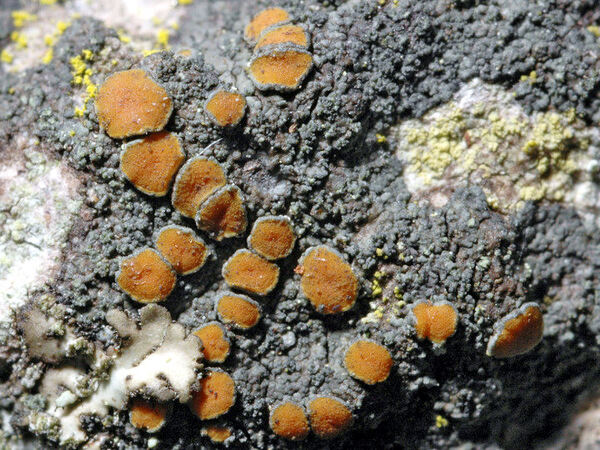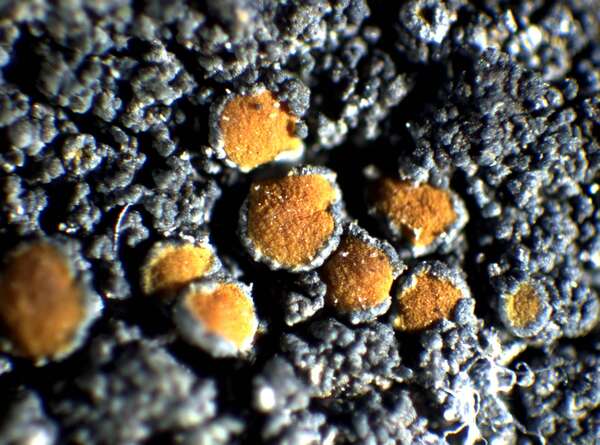Caloplaca chlorina (Flot.) H. Olivier
Flecht. Eur., 2: 122, 1909. Basionym: Zeora cerina var. chlorina Flot. - 27 Jahresber. schles. Ges. vaterl. Kultur: 126, 1849.
Synonyms: Caloplaca cerina var. chlorina (Flot.) Müll. Arg.; Placodium cerinum f. cyanopolium (Nyl.) A.L. Sm.; Placodium cerinum var. chlorinum (Flot.) Anzi
Distribution: N - Frl (Tretiach & Hafellner 2000), Ven (Nimis 1994, Nascimbene 2005c, 2008c), TAA (Nascimbene 2002, 2003, Thor & Nascimbene 2007, Nascimbene & al. 2022), Lomb (Favero-Longo & al. 2023), Piem (Isocrono & al. 2004), VA (Matteucci & al. 2015c). C - Abr (Nimis & Tretiach 1999).
Description: Thallus crustose, episubstratic, continuous to areolate, up to 0.6(-0.8) mm thick, densely blastidiate, olive grey to dark grey or almost black in sun-forms, sometimes delimited by a thin, dark prothallus. Areoles flat to convex, up to 2 mm wide, densely covered in granular blastidia sometimes forming isidia-like projections. Cortex up to 10(-30) µm thick, paraplectenchymatous; medulla white, poorly developed. Apothecia lecanorine, abundant to absent, up to 1.5 mm across, sessile, with a flat to slightly convex, pale to dark orange disc, and a thick, raised, blastidiate, grey thalline margin. Proper exciple indistinct, very thin, prosoplectenchymatous; epithecium brownish orange, with granules reacting K+ red; hymenium and hypothecium colourless; paraphyses simple to sparingly branched in upper part, 1-2 µm thick at base, the uppermost cells slightly swollen, 3(-5) µm wide. Asci 8-spored, clavate, functionally unitunicate, apically thickened with a broad internal beak, the inner part of apex and external cap I+ blue, Teloschistes-type. Ascospores 2-celled, polarilocular, hyaline, ellipsoid, (10-)11-14(-15.5) x 5-7 µm, the equatorial thickening (“septum”) 3.5-5.5 µm (c. 1/3 of spore length). Pycnidia rare, immersed, with a raised, dark ostiole. Conidia narrowly ellipsoid to bacilliform, 3-4 x c. 1 µm. Photobiont chlorococcoid. Spot tests: thallus K- or K+ violet, C- or C+ violet, KC-, P-; disc of apothecia K+ red. Chemistry: thallus with the Sedifolia-grey pigment; disc of apothecia with parietin (major), fallacinal, emodin, teloschistin and parietinic acid (minor).Note: on siliceous, nutrient-enriched rocks (rarely on limestone in damp sites), mostly in upland areas. The records of C. chlorina from the Alps reported by Nimis (1993: 159) are included partly here (silicicolous specimens), and partly under C. isidiigera (calcicolous specimens). See also Hafellner & Türk (2001).
Growth form: Crustose
Substrata: rocks
Photobiont: green algae other than Trentepohlia
Reproductive strategy: mainly asexual, by isidia, or isidia-like structures (e.g. schizidia)
Commonnes-rarity: (info)
Alpine belt: very rare
Subalpine belt: rather rare
Oromediterranean belt: absent
Montane belt: rare
Submediterranean belt: absent
Padanian area: absent
Humid submediterranean belt: absent
Humid mediterranean belt: absent
Dry mediterranean belt: absent

Predictive model
Herbarium samples
Growth form: Crustose
Substrata: rocks
Photobiont: green algae other than Trentepohlia
Reproductive strategy: mainly asexual, by isidia, or isidia-like structures (e.g. schizidia)
Commonnes-rarity: (info)
Alpine belt: very rare
Subalpine belt: rather rare
Oromediterranean belt: absent
Montane belt: rare
Submediterranean belt: absent
Padanian area: absent
Humid submediterranean belt: absent
Humid mediterranean belt: absent
Dry mediterranean belt: absent

Predictive model
| Herbarium samples |




